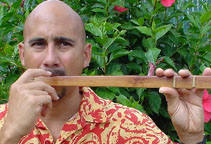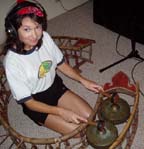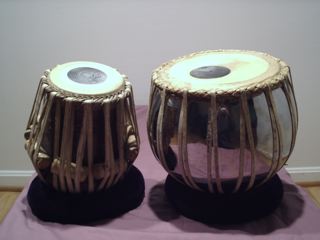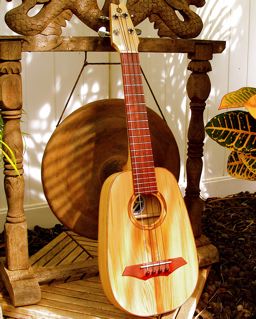

|
KotoK The koto is a 13-stringed zither with a harp-like sound made of paulownia wood. The instrument originated in China (gu zheng), and was introduced to Japan around the 7th century. The strings are stretched over notched, movable bridges, enabling the player to adjust the strings to any pitch or scale. >>More |
'Ohe hano ihu Literally "bamboo, breath, and nose" in Hawaiian, this flute has the unique distinction of being played with the nose which was considered to be purer than the mouth. It was often used in conjunction with chants and song, or to serenade a sweetheart. >>More |
Ki Ho'alu The Slack Key guitar is a Hawaiian tuning and style of guitar playing. Ki ho'alu literally means to slacken the key. This can be done on any guitar by detuning or "slackening" one or more strings to form a chord. There are many varieties of tunings, and they were often kept or known as family tunings. >>More |
 'Ukeke The only stringed instrument indigenous to Hawaii. Played with the mouth as a resonator and strummed with the hand. The ukeke shown here is made from Hawaiian koa wood and has three steel strings tuned to an A major triad. In the olden days gut or coconut string was used. >>More |
Ka'eke'eke Hawaiian stomping posts made from Hawaiian bamboo. Used as an accompaniment for hula as well as with traditional chants. Notice the tapa cloth end covers which protect the instrument during performances. >>More |
Khaen A traditional folk instrument from Thailand that utilizes brass free reeds placed in bamboo pipes which are activated when a small hole is covered with a finger while blowing air into the mouth piece. |
|
Kercapi A 2-stringed fretless lute played with a wooden plectrum native to the Batak people of Indonesia. Often decorated with ornate carvings. |
Tingklik The tingklik is a Balinese xylophone made of 11 bamboo pipes tuned to a pentatonic scale and played with rubber-tipped mallets. >>More |

Korng Thomm This Cambodian instrument is a large gong circle in which the performer sits in the middle surrounded with up to 16 brass/copper tuned gongs. >>More |
|
Suling The suling is an Indonesian end blown bamboo flute with 6 holes. There are two main finger positions for the pelog and sulendra scales. A distinguishing feature is the bamboo tied end which guides the air across the notched blow hole. >>More |
Sitar The sitar from North India is an 18-stringed lute type instrument with 7 main strings played above movable frets, while the 11 remaining strings (sympathetic strings) vibrate below the frets. It’s components are a hollow wooden neck attached to a pumpkin-shaped gourd. >>More
|

Tabla A pair of percussive instruments from India whose unique ecstatic sound has fascinated listeners around the globe. Consisting of a bass drum played with the left hand and a treble tuned drum played with the right hand. >>More played with the right hand. |
Guchin The guchin is a zither originating from China. It is an instrument of ancient beginnings dating back 3000 years. Considered a "scholar's instrument," it is rare to see it performed as only a few people play the guchin today. This is the "grand daddy" of the zithers and the written music from several hundred years ago still exists today. |
 Ukulele Literally "jumping flea" in Hawaiian. The name is derived from the fast right hand strumming witnessed when the instrument was introduced to Hawaiians by early Portuguese immigrants. This Pineapple tenor uke is a throw back to the pineapple plantation days. |
Shakuhachi A Japanese end-blown flute, the name refers to its length (1 shaku, 8 sun) which is about 54 centimeters. It is traditionally made of bamboo, but versions now exist in wood and plastic. It was used by the monks of the Fuke school of Zen Buddhism in the practice of suizen (blowing meditation). Its soulful sound made it popular in Western 1980s pop music. |
Puili Used in Hula as a rhythmic instrument. Made from bamboo and slitted length ways in thin strips which allow for a rattling sound. Usually used in pairs and bounced off of knees by a hula dancer during performance. |
Ihu hone The "mellow" nose flute. Extra long in length between nodes of Hawaiian bamboo, with an extra high note hole near the blow hole. Known for its sweet mellow tone. |
Pan pipes The pan flute or pan pipe (also known as panflute or panpipes) is an ancient musical instrument based on the principle of the closed tube, consisting usually of five or more pipes of gradually increasing length (and, at times, girth). |
Xiao The xiao is a Chinese vertical end-blown flute. It is generally made of dark brown bamboo (called "purple bamboo" in Chinese). It is also sometimes called dòngxiao, dòng meaning "hole." An ancient name for the xiao is shùdí (lit. "vertical bamboo flute"). |
Native American Flute "Lakota Style" is used most often to designate a five-hole flute. Confusingly is it sometimes also used to describe a "Plains" flute. "Southwestern Style" refers to a six-hole flute. Attached to the top of a native flute is a piece of wood, commonly called a "block," but it is also known as a "bird," "fetish," "totem," "saddle," and "slider."
|
Maui bamboo sax The original Maui Xaphoon (pronounced “za foon”), a "Bamboo Sax" for everyone who appreciates awesome sound but doesn’t want to schlep around a bulky instrument. The Xaphoon’s sound falls somewhere between a saxophone and a clarinet – a much richer sound than its size would suggest -- and was born to be played wherever and whenever the mood strikes. The experienced player will find the Xaphoon capable of all the subtle shadings and vibrant power of a saxophone. |
Hulusi The hulusi is a free reed wind instrument from China. It is held vertically and has three bamboo pipes which pass through a gourd wind chest; one pipe has finger holes and the other two are drone pipes. |
Rain Stick The rainstick is a long, hollow tube which is filled with small baubles such as beads or beans and has small pins arranged helically on its inside surface. When the stick is upended, the beads fall to the other end of the tube, making a sound reminiscent of a rainstorm as they bounce off the pins. The rainstick is generally used to create atmospheric sound effects or as a percussion instrument. |
Erhu The erhu, also called nanhu ("southern fiddle"), and sometimes known in the West as the "Chinese violin" or "Chinese two-string fiddle," is a two-stringed bowed musical instrument, used as a solo instrument as well as in small ensembles and large orchestras. It is the most popular instrument in the huqin family of Chinese bowed string instruments, together with the zhonghu, gaohu, banhu, jinghu, sihu, and numerous others. |
Angklung The angklung is an Indonesian tuned bamboo rattle. Two vertical bamboo tubes tuned an octave apart are fit into a horizontal slotted bamboo base. The tubes are carved so that they have a resonant pitch when struck. The sound is produced when the player shakes it rapidly from side to side, causing a rapidly repeating note to sound, like a rattle. The instrument consists of a series of bamboo tuned rattles suspended on a bamboo frame. |
Gamelan The instruments in a gamelan are composed of sets of tuned bronze gongs, gong-chimes, metallophones, drums, one or more flute, bowed and plucked string instruments, and sometimes singers. In some village gamelan, bronze is sometimes replaced by iron, wood, or bamboo. The most popular gamelan can be found in Java and Bali. |
Pipa The pipa is a plucked string instrument, sometimes called the Chinese lute, and has a pear-shaped wooden body. It has been played for nearly two thousand years in China. Several related instruments in East and Southeast Asia are derived from the pipa; these include the Japanese biwa, the Vietnamese dan ty ba, and the Korean bipa. |
Back to Home Page
Copyright © Ranga Pae - All rights reserved